Today we’re going to look at my Top 5 Dominant and Co-dominant Ball Python Morphs. These are the cheap but incredible genes that are the cornerstones of our hobby.
What kind of morphs are these?
All of the morphs discussed here are dominant or incomplete dominant genes. In general, most hobbyists still refer to incomplete dominant genes as “co-dominant” or “co-dom”, hence the title of this post. To be honest, most of us know that incomplete dominance is more scientifically correct, but the term co-dom has really stuck!
As you are probably aware, recessive morphs like Piebald and Clown tend to be more expensive, but dominant and incomplete dominant genes are always added to enhance them. For example, Clown is cool – but Pastel Clown is cooler!
Dominant and incomplete dominant morphs aren’t just great to combine with recessive genes though. They also mix extremely well with each other. If you wanted to, you could create several designer combos simply by breeding together the genes in this article.
In a nutshell, these “essentials” are usually the building blocks for new or highly unusual combination morphs.

A nice Pastel Clown. It’s in combos such as this that genes like Pastel shine.
How have I chosen these essential Ball Python morphs?
Each morph in this list has proven, lasting popularity thanks to its uniqueness, beauty, and flexibility. Some have a long history and feature in most of the designer combos created over the last 20 years. For example, Pinstripe is involved in the Lemon Blast, Dragonfly and Spinner Blast combos, to name just a few.
Another criterion for choosing these genes was their prevalence in the hobby. If you get into breeding, you will definitely encounter them. They are all incredibly common in every country where Ball Pythons are kept and bred. For this reason, you need to understand how they work.
1. Pastel Ball Python
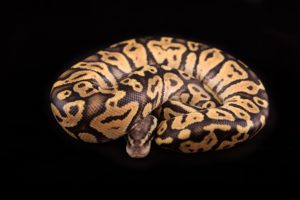
Pastel is an incomplete dominant gene, meaning it has a (stunning) super form. First produced by NERD (New England Reptile Distributors) in 1997, it is now in every single collection around the world.
Its main attribute is a nice yellow colour. This is one of the most important aspects for many breeding projects – adding colour. That’s why I’d argue Pastel is THE single most essential Ball Python morph.
For a lot of us veteran keepers (I started in the late 90’s) Pastel also has sentimental value. It was the first Ball Python morph we ever saw or owned. I’d even go out on a limb and say some of us got into the hobby because of this gene.
Overall, it has played a huge role in making this species popular and encouraged captive breeding rather than wild collection.
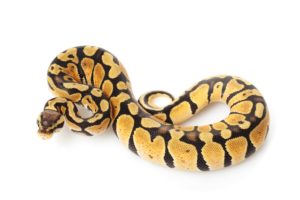
2. Enchi Ball Python

First bred in captivity by Lars Brandell of Sweball.com in 2002, Enchi has bright yellow/orange colour and solid, wide bands of pattern. Being incomplete dominant, it does of course have a super form that increases this effect.
Enchi has two main functions. First is a reduction in pattern, making it look cleaner. Second is a change in colour. This can be subtle in some combinations, but more pronounced in others. If you get it right, you end up with a snake that has nice, broad saddles on its back and a deep, mahogany colour.
Obviously, this gene is extremely popular, but be careful what you do with it… It works incredibly well with Clown for example, increasing the colour intensity and cleaning up the pattern. Conversely, you wouldn’t want to mix it with a gene like Acid. This would counteract the bubbling and jumbled-up pattern that many people enjoy in the Acid morph.
In my opinion, it works best in morphs that have very little pattern like Champagne. In this case, it creates some aberrant-looking pattern which looks extremely attractive.
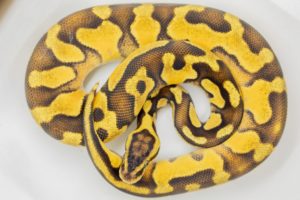
I’m not entirely sure what genes asides from Enchi are in this morph. What I do know is that it looks incredible.
3. Cinnamon Ball Python
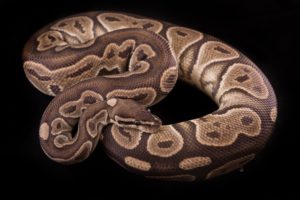
And now for one of my personal favourites! This is a dark, incomplete dominant morph that usually has a greater effect on colour than on pattern. Overall, it changes the pattern to nice, rich brown blotches on a dark, almost black background. The belly is white.
Cinnamon has brought us some classic combos such as Pewter (Cinnamon and Pastel) and Savannah (Cinnamon and Mojave), but also has an incredible super form. Super Cinnamons are often almost jet black, and certainly make an impression when you see them. Unfortunately, many breeders are reporting that they are prone to birth defects, and it may be best to avoid creating them.
When added to other genes Cinnamon can have a surprising effect. When combined with Coral Glow, for example, it increases the contrast between the yellow pattern and its background. In juveniles, this can help make the background into a deeper, more intense purple colour.
In other combinations, this gene has the interesting effect of creating striping. Cinnamon Leopard and Cinnamon Bongo Ball Pythons both have nice, deep colour and striping almost all the way down their dorsum.
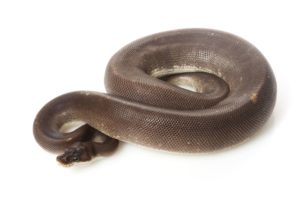 A sub-adult Super Cinnamon Ball Python.
A sub-adult Super Cinnamon Ball Python.
4. Orange Dream Ball Python
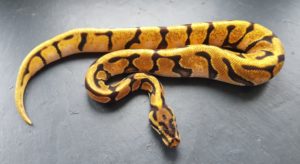
The Orange Dream Spotnose Fire Ball Python gives us a glimpse of this gene’s potential.
Another incomplete dominant gene, Orange Dream has a subtle but beautiful effect on both colour and pattern.
Admittedly, it can be hard to ID in some combos, but get it right and you can produce some of the most striking high-end combination morphs on the market. Orange Dream cleans up pattern, reduces blotches and bubbling and – you guessed it – adds a beautiful orange colour.
In its super form, this gene has a much more drastic effect. Indeed, the homozygous form of the morph has very clean orange bands of pattern on a black background. Mix in genes like Enchi or Spider and you can create combinations that look incredibly unique.
Orange Dream was first produced by Ozzy Boids in 2004, making it the newest morph on the list. And whilst it isn’t quite as universally well known as Pastel, it has taken off extremely well.
Almost every major breeder is now working with it to enhance their projects. My prediction is that Orange Dream will be as essential as Pastel very soon and remain so for as long as this hobby is around.
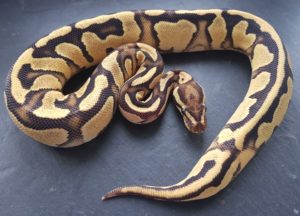
An OD Fire het Pied Ball Python.
5. Pinstripe Ball Python

A true old-school gene, Pinstripe has been around since 2001, when it was first produced by BHB Enterprises. Since then, it’s found its way into a vast number of designer combos. In fact, anything with “Blast” in the name has Pinstripe in it.
Even to this day, Pinstripe is finding its way into high-end morphs like the stunning Desert Ghost Pinstripe, and for good reason. You get huge bang for your buck with this gene! It completely changes the snake’s pattern and gives a nice, golden-brown colour.
Being the only dominant gene on the list, Pinstripe has no super form. It does however make up for this by being very visually expressive and impossible to miss in most combinations.
What’s more, because of its broad areas of colouration, it produces a nice effect with Albino and Coral Glow. Albino Pinstripe Ball Pythons are almost completely orange, save a few white lines of pattern.
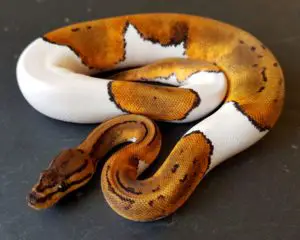
A juvenile Pinstripe Pied Ball Python.
Other dominant and co-dominant morphs
Obviously in this article I’ve listed what I consider to be the “essential” dom’ and co-dom’ morphs – but don’t just take my word for it. There’s a whole bunch of other morphs that could be just as incredible when used in breeding projects, and which are becoming just as widespread as the ones I’ve already listed.
Some cheap, abundant and amazing dominant morphs include:
- Calico
- Sugar
- Woma
- Leopard
Other co-dominant (also known as incomplete dominant) morphs include:
- Yellow Belly
- Black Pastel
- Butter
- Lesser
- Chocolate
- Mystic
- GHI
- Phantom
- Mojave
- Fire
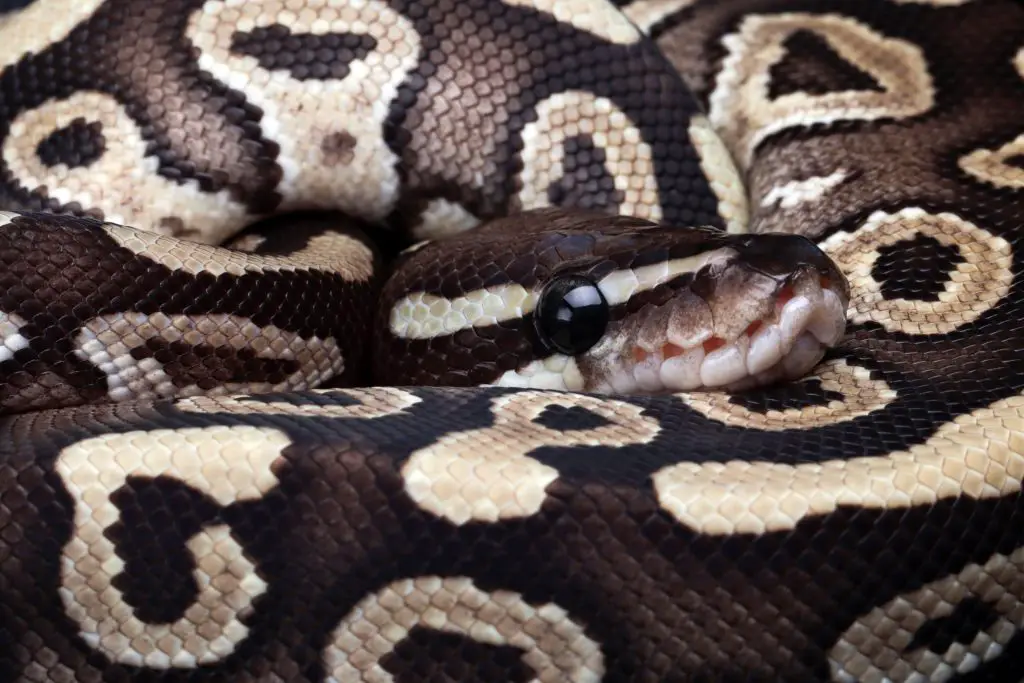
In Conclusion
These morphs aren’t all new or exciting – but you need to know about them! If they’re on this list, it’s because they’ve made their way into almost every single popular combination morph so far.
You might see genes like Pastel or Pinstripe for sale at incredibly low prices, and think “I can ignore these, they’re not a worthwhile investment.” Notwithstanding, nothing could be further from the truth.
When it comes to breeding Ball Pythons, you’ll encounter the genes discussed here over and over again. You need to know what they do, what combinations they’re involved in, and how they might interact with other genes.
Fortunately, I did the homework for you! I hope you’ve enjoyed it, but if there’s anything else you need to know please get in touch.
